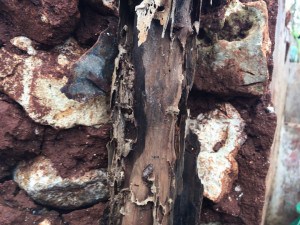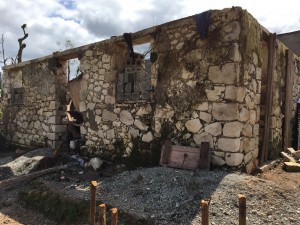Today we drove from Jeremie toward the mountains in the middle of the Grande Anse department. On the bumpy road along the Grande Anse River we saw dozens of houses with heavy damages from the hurricane. The houses are mainly constructed with a wood frame and stone masonry. The wind force shocked the buildings, provoking the fall of the top corners of some walls and cracks near the column joints. The use of mud mortar to place the stones is insufficient to tie the stone together well. We saw houses that withstood the hurricane better when they were plaster with cement mortar. Foreman are using untreated wood to build the frame with a spacing of typically 1m. The wood elements are not saw lumber, but generally round wood approximately 7-10cm diameter. On the most damaged houses we saw that the wood was deteriorated by termites and humidity.
The great majority of houses in unreinforced masonry have little cracks, but many have lost their roofs as they were poorly connected to the top of the wall. For this type of building, the wall-to-rafter connection is typically a piece of bent rebar around the rafter. We observed failure of block masonry walls when the span of the wall was more than 4m without a ring beam. Retrofitting would be an interesting solution for these buildings, and would involve adding a ring beam and columns at the corners. Nevertheless, the quality of the blocks should be investigated thoroughly, as they appear to be very fragile.
We saw a few houses built with stone masonry that behaved well, but the connection to the roof failed and the roof was destroyed.
We arrived in Moron, a town located on a hill surrounded by mountains and not far from a large river. All the trees around the town are destroyed.
We had a talk with the Deputy Mayor, who told us that even if the situation in the city center – where about 90% of the lightweight roofs were blown away – appears critical, the situation in the communal sections 2 and 3 was even more dramatic. These two sections are located on the other side of the river, and the cable bridge crossing the river has been severely damaged by the hurricane. People have to cross the river by foot in order to access the market. In these areas, the houses are built from mud and wood. The Deputy Mayor considers the town completely destroyed.
We assessed a few dozen houses in Moron to understand the type of failure and extent of the damage. We met with Samedi Camecise, who lost her house during the hurricane. She described a sudden, total collapse of her house, after which she and her son found shelter in a neighbor’s house made from unreinforced masonry.
The quality of construction materials is a major challenge in the area. We saw pile of sand extracted directly from the river bed. The sand is sold without being washed. The block quality is very poor as many manufacturers put clay in blocks. The CGI are mostly substandard, and were deteriorated and rusted before the hurricane. We interviewed people about their knowledge in quality material selection and it appeared that they have little knowledge due to lack of training. We surveyed material shops in Moron and Jeremie and found that the materials are generally available in the cities but very scarce when not accessible by the road.






